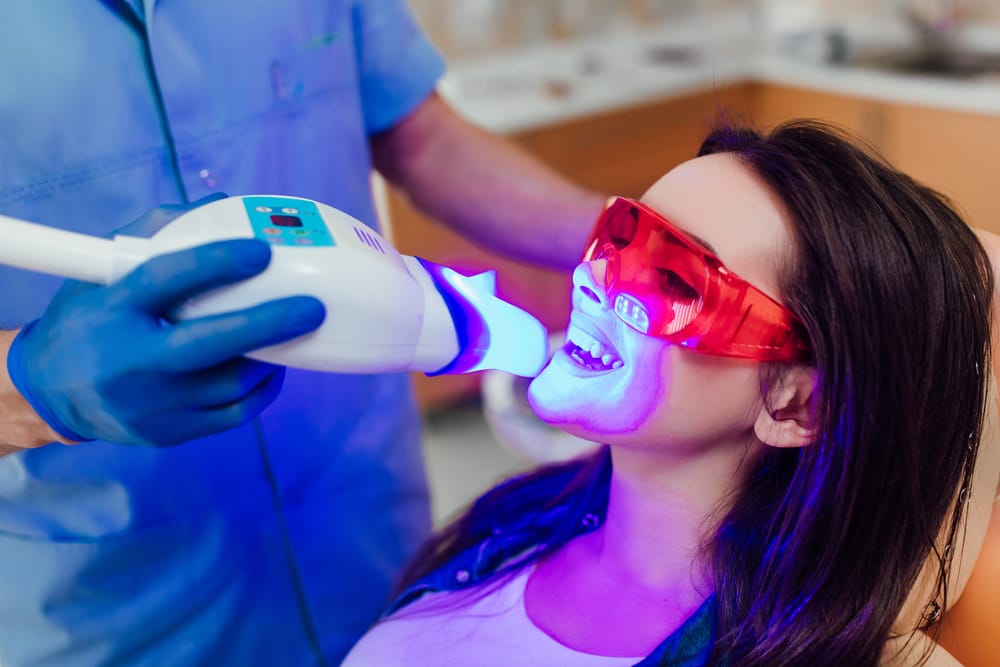We all want to have a bright, beautiful smile that radiates confidence. Unfortunately, our teeth are constantly exposed to various substances that can cause discoloration and staining. Our teeth can lose their natural white luster over time, from coffee to wine, food dyes, and even certain medications. But fret not! Teeth Whitening is an easy and effective way to give your pearly whites the boost they need. In this blog post, we will delve into the science behind teeth discoloration and compare different methods of teeth whitening available in the market today. Lastly, we’ll answer some common questions about whether or not teeth whitening is suitable for everyone. Get ready to say cheese with confidence!
Causes of Extrinsic Stains
Extrinsic stains, also known as external stains, are primarily caused by consuming beverages with stain-inducing properties. For example, common culprits like red wine, coffee, and tea can leave visible discoloration on the surface of teeth. Another major contributor to extrinsic tooth discoloration is tobacco use, whether smoking or chewing. Inadequate dental hygiene practices, such as not brushing and flossing regularly, can lead to plaque buildup and stain-causing agents. It’s also worth noting that certain acidic foods, like citrus fruits and soda, can erode tooth enamel over time, making teeth more susceptible to extrinsic stains. Regular dental cleanings are highly recommended to prevent and remove surface stains caused by these external factors. By addressing the causes of extrinsic stains, individuals can take proactive steps toward achieving a brighter smile.
Causes of Intrinsic Stains
Intrinsic stains, which occur within the tooth enamel, can have various causes. Certain medications, like tetracycline, taken during tooth development can lead to intrinsic discoloration. Dental trauma, such as a fall or injury, especially when the tooth pulp is affected, can also result in intrinsic stains. Excessive fluoride exposure from natural sources or supplementation is another factor that can contribute to intrinsic tooth discoloration. Medical conditions like enamel hypoplasia or dentinogenesis imperfecta can also cause intrinsic stains. Due to their penetration into the tooth enamel, intrinsic stains may require different whitening methods than extrinsic stains. Understanding these causes is essential to choosing the most suitable whitening solution for achieving a brighter smile.
Professional In-office Whitening
Professional in-office whitening is a teeth whitening procedure performed by dental professionals. It utilizes whitening agents such as hydrogen or carbamide peroxide to brighten the teeth. The process involves applying a whitening gel onto the teeth, which is then activated by a light source, typically LED. This method offers faster and more dramatic results, often lightening the teeth by several shades in just one session. Dental professionals have the expertise to customize the whitening treatment according to individual needs, ensuring better outcomes while minimizing side effects. It is important to note that professional whitening procedures are generally safe, as dental professionals take precautions to protect the gums and tooth enamel during the process.
Recommendations for Sensitive Teeth
Individuals with sensitive teeth should consider using toothpaste specifically formulated for sensitive teeth, which often contains potassium nitrate or fluoride to help alleviate sensitivity. Gradually increasing exposure to whitening agents, starting with lower concentrations, can help individuals with sensitive teeth tolerate the teeth-whitening process better. Taking breaks between whitening sessions giving teeth time to recover, can also help minimize tooth sensitivity. Dental professionals may recommend additional measures, such as fluoride gel or dental restorations, to protect sensitive teeth during whitening. Seeking dental guidance, especially for individuals with sensitive teeth, is crucial in determining the most appropriate teeth whitening approach. By following these recommendations, individuals with sensitive teeth can still achieve a brighter smile through teeth whitening without experiencing excessive discomfort or sensitivity.
Factors Influencing the Duration of Whitening
Factors such as tooth color, natural enamel thickness, and dental plaque significantly determine the duration of teeth whitening effects. Individual variations in these factors can impact how long the whitening lasts. Additionally, lifestyle habits like tobacco use and consumption of stain-inducing beverages contribute to tooth discoloration, shortening the longevity of whitening effects. It’s important to note that dental restorations, such as crowns or fillings, do not whiten like natural teeth, and their presence can affect the overall results. However, with proper dental care, including regular cleanings and following personalized recommendations from dental professionals, individuals can maintain a brighter smile for a longer duration. Dental professionals consider various individual factors to provide tailored advice for achieving and sustaining long-lasting teeth whitening results.
Maintenance Tips for Prolonged Effects
To maintain the prolonged effects of teeth whitening, avoiding stain-causing foods and beverages such as coffee, tea, and red wine is essential. Practicing good oral hygiene by regularly brushing and flossing helps prevent the buildup of plaque and tartar, preserving the brightness of your smile. Using a whitening toothpaste can also aid in maintaining the results of your teeth whitening treatment. Consider touch-up treatments every 6-12 months to keep your smile looking bright and white. Before undergoing any teeth whitening procedure, it’s essential to consult with your dentist to ensure that your teeth and gums are healthy. By following these simple maintenance tips, you can enjoy the benefits of teeth whitening for a longer duration while flaunting your pearly whites.
Conclusion
In conclusion, teeth whitening can be a fantastic way to enhance your smile and boost your confidence. Understanding the causes of teeth discoloration and comparing different whitening methods will help you make an informed decision. It’s essential to prioritize safety and follow the recommended precautions, especially if you have sensitive teeth. Remember that the whitening effects’ longevity may vary based on various factors, but proper maintenance can help prolong the results. If you’re considering teeth whitening, it’s always best to consult a dental professional to determine if it suits you. So why wait? Brighten your smile and let your confidence shine through!


 Meet Dr. Leffler
Meet Dr. Leffler
 Meet the Team
Meet the Team
 Dental Membership Plan
Dental Membership Plan
 Insurance Information
Insurance Information
 Patient Forms
Patient Forms
 Online Bill Pay
Online Bill Pay
 Your First Visit
Your First Visit
